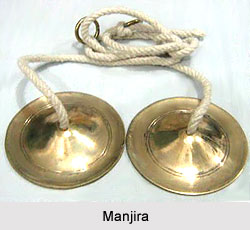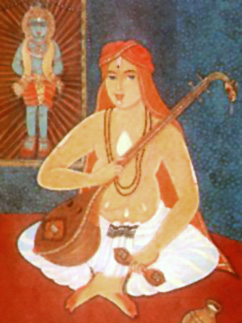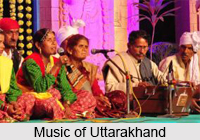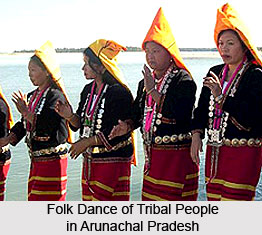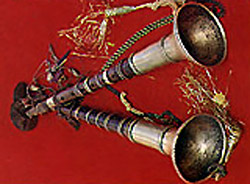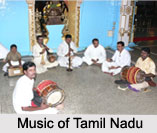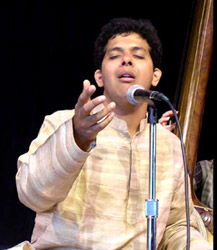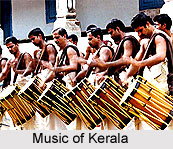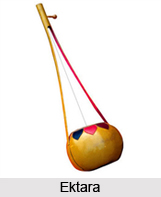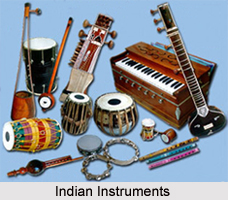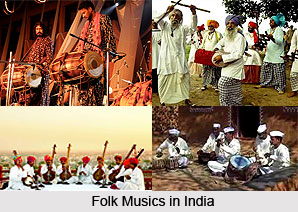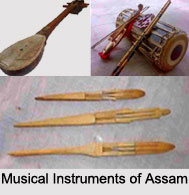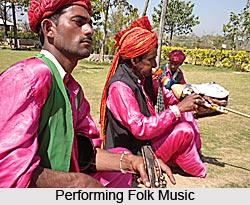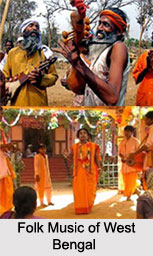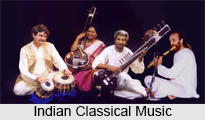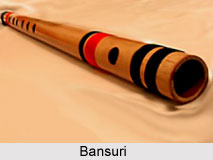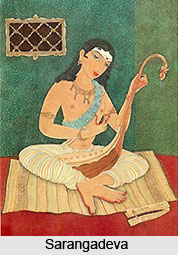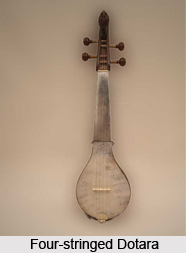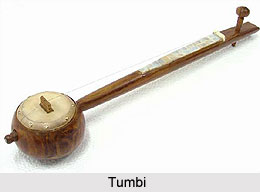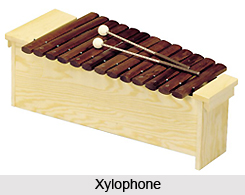Origin of Agra Gharana
The Agra gharana, derived from the Nauhar Bani, is a renowned lineage of Hindustani classical vocal music. The origins of Nauhar Bani can be traced back to approximately 1300 AD, during the reign of Emperor Allauddin Khilji of Delhi.
Nayak Gopal stands as the earliest documented musician associated with this rich tradition. During that era, the prevailing style in the Gharana was "Dhrupad-Dhamar." Ghagghe Khudabuksh (1790–1880 AD) played a pivotal role by introducing the "Khayal" style from the Gwalior Gharana into the Agra gharana. Khudabaksh had acquired this style from Natthan Paribaksh of Gwalior.
History of Agra Gharana
The Agra gharana, renowned for its distinctive style of Hindustani classical vocal music, carries a rich history that is shrouded in mystery. Exploring its origins takes us back to the reign of Emperor Allauddin Khilji of Delhi, around 1307 AD. During this time, the celebrated Amir Khusro accompanied the emperor on a victorious campaign against King Ramachandra of Devagiri. It is believed that Amir Khusro`s purpose in joining the campaign was to meet Nayak Gopal, an esteemed musician from Devagiri. Following the restoration of the defeated king to his throne, Nayak Gopal was persuaded to accompany Amir Khusro and Emperor Allauddin Khilji to Delhi, where he laid the foundation of a distinct music system known as the Nauhar Bani. Within the lineage of the gharana, one of Nayak Gopal`s descendants emerged as a prominent figure at Akbar`s court in Agra. Sujan Das, known as `Nauhar,` possessed extraordinary musical prowess, often considered on par with the legendary Tansen. Akbar held Sujan Das in high regard, prompting him to convert to Islam and undertake the Haj pilgrimage. From that point forward, he was known as Haji Sujan Khan, a name revered by all musicians associated with the Agra Gharana. During this period, the prevalent styles of music included alap, dhrupad, dhamar, and the rudiments of khayalgayaki in the form of Khusravi Mausiqi, the precursor of khayal.
The era of Aurangzeb`s reign brought significant challenges to the musicians associated with the Agra Gharana. Haji Sujan Khan`s great-great-grandson, Dayam Khan `Nauhar,` also known as Saras Rang, served in the Mughal court. However, Aurangzeb`s ban on music forced talented musicians, including those who had migrated to Delhi for royal patronage, to return to their hometowns and establish their own musical traditions. Saras Rang returned to Agra, where he continued to nurture his musical pursuits.
From the reign of Akbar to the period of Aurangzeb, the musical tradition passed down through Nayak Gopal, Haji Sujan Khan, and their descendants was known as Nauhar Bani. The term `bani` signifies a tradition or system of music, while `gharana` refers to a house of music. Indeed, `gharana` is an extension of the word `ghar,` meaning house. Consequently, the various houses of music established by different musicians in their respective locations came to be known as gharanas, distinguished by the names of the towns or villages that served as their prefixes. Thus, Nauhar Bani became primarily associated with the Agra Gharana, with Saras Rang serving as its originator.
A significant influence on the Agra Gharana emanated from the Atrauli Gharana of Gobarhari Bani, with Mehboob Khan `Daras Piya` serving as its most prominent musician. Natthan Khan, the maestro of the Agra Gharana in the 19th century, married Jasiya Begum, the sister of Daras Piya. Faiyaz Khan, too, entered into matrimonial ties with Daras Piya`s daughter. Ata Hussain Khan, the son of Daras Piya, initially trained by his father, eventually became a disciple of Faiyaz Khan and spent many years under his guidance. Moreover, musicians and teachers of the Agra Gharana, such as Khadim Hussain Khan, Latafat Hussain Khan, and Sharafat Hussain Khan, were born into the Atrauli khandan but received instruction from ustads of both the Agra and Atrauli Gharanas. Consequently, they showcased a beautiful amalgamation of the two styles, and the tradition aptly became known as the Agra-Atrauli Gharana/
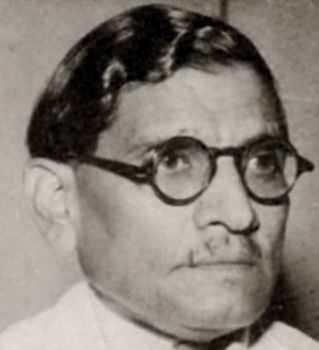 History of Agra Gharana is one of an old system of family tradition. Gharana itself is rooted in family tradition. When a characteristic mode of music is preserved and groomed in a particular family, becoming a tradition, it is termed Gharana. In the various contemporary gharanas, the Agra gharana enjoys a position of repute. That the Agra Gharana possibly absorbed attractive features from other Gharanas, yet its own inherent characteristics are present even today, is obvious. It may be noted here that this gharana pertains to vocal music only, and has no counterpart in instrumental music, and that it has had a distinct style in Dhrupad, Dhamar and Khayal. As far as the musical forms are concerned, Dhrupad, Dhamar, and Khayal have always been a part of Agra gayaki.
History of Agra Gharana is one of an old system of family tradition. Gharana itself is rooted in family tradition. When a characteristic mode of music is preserved and groomed in a particular family, becoming a tradition, it is termed Gharana. In the various contemporary gharanas, the Agra gharana enjoys a position of repute. That the Agra Gharana possibly absorbed attractive features from other Gharanas, yet its own inherent characteristics are present even today, is obvious. It may be noted here that this gharana pertains to vocal music only, and has no counterpart in instrumental music, and that it has had a distinct style in Dhrupad, Dhamar and Khayal. As far as the musical forms are concerned, Dhrupad, Dhamar, and Khayal have always been a part of Agra gayaki.
History of Agra gharana can be better understood by taking a look at the principal singers and their lives. One of the most prominent and first among the singers of the Agra gharana is Haji Sujan Khan or Sujandas Nauhar.
Gharana of Haji Sujan Khan
It is corroborated by the contemporary singers of this gharana that this gharana was started by Haji Sujan Khan. According to literary evidences, he was a Rajput who converted to Islam and was a singer in Emperor Akbar`s court. Legend has it that he lit lamps by singing dipaka raaga, and Akbar in high appreciation, honoured him with the title, Dipak Jyot. Sujan Khan was also a composer. Many dhrupads, with his name Sujan occurring at the end, are found and sung even today. According to some, Sujan Khan and Tansen were contemporaries. In fact, Tansen is believed to have liked his singing so much that he got his daughter married to Vilayat Khan.
Another famous singer from this gharana was Tasadduk Husain Khan who was well versed in the theory. The late Vilayat Hussain Khan, when speaking about the history of the Agra Gharana, acknowledged that Sujan Khan was the root of this gharana family.
In the list of Haji Sujan Khan`s predecessors, one Niranjandas is mentioned. Niranjandas was possibly someone between Ramdasji alias Nayak Dhondu, and Sujandas Nauhar. Sujan Khan had four sons namely, Alakadasa, Malakdas, Khalakdas, and Lavangdas. The genealogy from Malakdas down to the present is traceable.
Shyamarang and Sarasrang
They were the sons of Malakdas, both of them Dhrupad Singers. They were excellent in their art and Natthan Khan and Pirbakhsh of Gwalior learnt many dhrupad-dhamar from them. It is believed that on this basis of dhrupad-dhamar, Natthan Khan and Pirbakhsh created their own khayals which were pure of form and had classical weightage. Patronized by Virbhadrasinh, the king of Kashi, Shyamarang and Sarasrang lived at Agra. Many cijas composed by Sarasrang are sung even today. Agra Gharana specialized in dhrupad nearly till the death of Natthan Khan (d. 1901). Janghu Khan, Susu Khan, Gulab Khan, the sons of Shyamarang learned dhrupad and were accomplished singers of it.
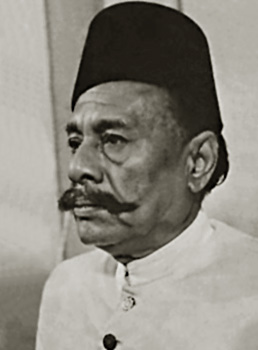 Ghagghe Khudabaksh
Ghagghe Khudabaksh
The youngest of the sons of Shyamarang was Ghagghe Khudabaksh. Due to some inherent fault in his voice he was unable to learn the music of the family. He was determined to master some other style of singing if not dhrupad, and impressed by his craving to learn Natthan-Pirbaksh undertook to coach him. He went on to become a singer of great merit and was held in much reverence by the other well known singers of the time. It was Ghagghe Khudabaksh who ushered in the practice of khayals into the staunch Dhrupad-Dhamar Gharana.
Natthan Khan
Natthan Khan was another of the great masters of the Agra tradition. He was quick in absorbing many attractive features from sources other than his gharana. He, for instance learnt dhrupads from Ghasit Khan of Fatehpur Sikri. He was patronized by Nawab Kalian of Jaipur, hence came into contact with Mubarak Ali Khan, Imratsen Sitariya, Khairat Ali Khan, Bade Rajabali Khan, Mohamad Ali Khan, and others of the Jaipur court. It was as a result of all this that he introduced the layakan technique of dhrupad in his khayals, making them more attractive. Use of tanas and bola-tanas set to vilambita laya, coguna and athaguna lava of the same bola-tanas and employing kuad-ki-firat, made his khayal unique.
Vilayat Husain Khan
Vilaiyat Hussain Khan was Natthan Khan`s son, and he went on to become an awe-inspiring singer. From the age of 20, he carved out a name for himself among the singers of the day. He was at Mysore and Jaipur courts, but made Mumbai his home, training a large number of disciples there. Vilayat Khan is known to have learnt from 42 different ustads, the number of raagas or cijas learnt from each varying from 5 to 50. The sphere and reputation of Agra Gharana gained much from him. He was awarded the titles Sangitacarya (Mysore Court) and Sangita Ratnakara (Allahabad Sangit Parishad).
He was very fond of writing sayaris, and composing bandisas. He has written quite a few ghazals using pseudonym "Shafaq". He has composed bandisas in maluha kedar, natbihaga, joga, bahaduri Todi, kukubh-bilavala, etc. in Braja Bhasa, using the pseudonym "PranPiya". Quite a few uncommon raagas sung by him have been recorded by All India Radio. He died in 1962, when he was a music adviser in All India Radio, Delhi.
Faiyaz Khan
Faiyaz Khan has been truly acclaimed the most eminent singer of the Agra Gharana, a towering personality of Hindustani classical music, of all times. On his father`s side Faiyaz Khan was associated with "Rangila Gharana". The founder of this gharana, Miyan Ramjan Khan "Rangile" was a disciple of dhrupad singer Imambakhsh of Jodhpur. From an early age, Faiyaz Khan had exposure to many musicians and a varied concert experience. By the time he was 20, Faiyaz Khan became a prolific singer. His first honour came as a medal from Krishnaraj Wadiyar in 1906. From 1907 to 1910 he was at Kolkata and there he learnt thumri and dadra from Ganapatrao Bhaiya. He was not averse to learning from other gharanas. So he learnt many cijas from Mehbub Khan (his father-in-law) and Kale Khan, and thumri expert Moujuddin Khan. Thus, he could command khayal, dhrupad, dhamar, thumri, dadra and ghazal with equal ease, but he was at his best in khayals. Almost all the singers of the time used a very high pitch, ignoring the natural range of one`s voice. Faiyaz Khan used his natural voice belonging to the lower octave. He could project his voice, giving it volume and weight. This made his vilambit and non-thom alaap serene and majestic.
Faiz Mohmad khan of Baroda court was responsible for Faiyaz Khan`s coming to Baroda in 1912. He lived there till his death on November 9, 1950. Using the pseudonym "Prem Piya" he composed many cijas, which bring out the true form of a raaga, help in developing it and have a subtle meaning too.
Thus the aforementioned discussion traces the development of the Agra Gharana right from the time of its initial conception. The gharana has been kept alive by the people trained by the great masters and their followers. The present form of Agra Khayal owes much to the principal singers of the gharana. Each of them had individual style and talent with which they enriched the gharana art.
Features of Agra Gharana
As a khayal gharana, the Agra gharana took shape during the course of the 19th century, through the grand-disciples and descendants of Shyamrang. Of all the known khayal styles, it is the Agra singers who proudly parade their dhrupadic roots and influences most in their renditions. There are some rather outstanding features of Agra gharana gayaki most of which are typical to the Agra gharana. The gharana adopts a kind of voice production which relies on a flatter version of the vowel sound "a"`, which makes its music agreeable to rhythmic variations and is best suited for a deep masculine voice. Emphasis is laid on bold, full-throated and robust voice production, and singing in the lower register (mandra) is favoured. Keeping in tune with its dhrupadic origins, the singers use broad and powerful ornamentations (gamaks), extensive glides (meends), and resonant articulations of notes. As with the Gwalior gharana, the Agra singers accentuate the importance of the bandish and its methodical exposition. Singers following Faiyaz Khan`s style resort to the dhrupadic nom tom alaap before singing the bandish. The singers of this gharana are also great masters over laya-kari or the rhythmic component. In fact, laya-kari is the lasting foundation on which the singers build the edifice of the bandish. In the hands of the best exponents, the dialogue between the singer and the tabla player often turns a dramatic event. Their tihais are eagerly awaited, as are their nifty ways of arriving at the same, by building up anticipation within the listener
Musicians of Agra Gharana
The Agra Gharana, renowned for its unique blend of dhrupad and khayal gayakis, boasts a lineage of exceptional musicians whose voices have stirred the hearts of listeners for generations. Ghagge Khudabaksh (1790–1880), the creator of the harmonious amalgamation of dhrupad and khayal, possessed a melodious voice that evoked deep emotions in the listeners. However, his performances were rarely witnessed at joyous occasions like weddings, as his renditions had the power to bring tears to the eyes, which was considered taboo in such settings. Sher Khan (1802–1882), the first musician from the family trained by Ghaggeji upon his return from Gwalior, was an exceptional artist. Invited to perform across the country, Sher Khan played a pivotal role in bringing the gharana to Bombay in 1840, where it flourished and became the primary seat of the gharana in the following century.
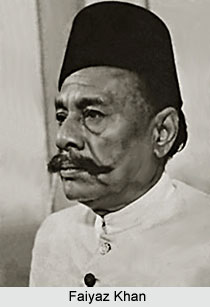 Ghulam Abbas Khan (1825–1934), the elder son of Ghagge Khudabaksh, possessed remarkable breath control, ensuring that his performances were marked by tremendous stamina. Kallan Khan (1835–1925) closely resembled his father Ghaggeji`s style of singing, with a particular focus on the melodious aspect of the musical style. He became a worthy successor to his father, enthralling audiences in the Jaipur darbar. Natthan Khan (1840–1901), the son of Sher Khan, received rigorous training from his cousin Ghulam Abbas Khan and emerged as one of the greatest performers of his time. His fame spread far and wide, and he was the first Hindustani classical musician to be appointed as the asthaanagavaiya (resident musician) in the distant Mysore, a stronghold of Carnatic music.
Ghulam Abbas Khan (1825–1934), the elder son of Ghagge Khudabaksh, possessed remarkable breath control, ensuring that his performances were marked by tremendous stamina. Kallan Khan (1835–1925) closely resembled his father Ghaggeji`s style of singing, with a particular focus on the melodious aspect of the musical style. He became a worthy successor to his father, enthralling audiences in the Jaipur darbar. Natthan Khan (1840–1901), the son of Sher Khan, received rigorous training from his cousin Ghulam Abbas Khan and emerged as one of the greatest performers of his time. His fame spread far and wide, and he was the first Hindustani classical musician to be appointed as the asthaanagavaiya (resident musician) in the distant Mysore, a stronghold of Carnatic music.
Breaking the gender norms of the time, Zohrabai Agrewali (1868–1913) became one of the first women to master the Agra gayaki, which had traditionally been the exclusive domain of male musicians. Trained by two greats of the gharana, Sher Khan and Kallan Khan, Zohrabai was among the earliest women musicians to record her music, paving the way for future generations. Bhaskarbuwa Bakhale (1869–1922), a disciple of Natthan Khan, was one of the few Hindu musicians in the nineteenth century who equaled, and in some cases surpassed, the top Muslim ustads of his time. He earned the title `Deva Gandharva,` signifying his exceptional musicianship. Mohammed Khan (1870–1922), the eldest son and disciple of Natthan Khan, possessed an encyclopedic knowledge of rare and intricate ragas. Even musicians senior to him acknowledged that a raga unknown to Mohammed Khan was not worth knowing.
Abdullah Khan `Manhar Piya` (1873–1920), the second son and disciple of Natthan Khan, carried forward his guru`s singing style with great precision. Tasadduq Hussain Khan (1876–1946), the son of Kallan Khan, excelled not only as a musician but also as a composer, historian, and custodian of the gharana`s ragas and compositions. Vilayat Hussain Khan `Pran Piya` (1892–1962), the fourth son of Natthan Khan, emerged as a distinguished musician, revered teacher, and prolific composer. Ata Hussain Khan (1898–1980), the son and disciple of Atrauli`s Daras Piya, enriched his musical prowess under the guidance of his brother-in-law Faiyaz Khan, providing vocal support and sharing a deep musical bond for nearly 25 years.
One of the greatest contributions in this field has been made by Ustad Faiyaz Khan who altered the course of the tradition in dynamic and profound ways. The more finicky connoisseurs, however, place him in the `Rangile` tradition. The differences between the Agra gayaki and its close cousin, Rangile, would be a musicologist`s obsession, rather than a listener`s. In fact, for the most part, Faiyaz Khan`s name has come to be associated with the pulsating colour, the forceful energy and the rugged dignity of the Agra tradition. His husky and sonorous voice, which he used with great effect in his masterly nom tom alaaps in the dhrupadic style, made him one of the finest exponents of the gharana gayaki, especially its accentuation on maintaining the emotional ambience and the tonal transparency of the raaga. A highly versatile singer, besides dhrupad-dhammar and khayals, he also sang thumris and dadras with great feeling.
Faiyaz Khan`s disciples, the late Latafat Khan and Sharafat Hussain Khan, closely follow their master`s style. Interestingly enough, the great playback singer Kundan Lal Saigal, learnt under Faiyaz Khan for a while. The gruff nasality so typical of Saigal, often reminds one of Faiyaz Khan`s distinctive diction.
Srikrishna (Annasaheb) Ratanjankar (1900–1974), a prominent disciple of the renowned musicologist Vishnu Narayan Bhatkhande, was sent by Bhatkhande himself to Faiyaz Khan for rigorous musical training. Ratanjankar became one of the most distinguished disciples of Faiyaz Khan outside the khandan. Dilip Chandra Vedi (1901–1992), having learned directly under two gharana greats, Bhaskarbuwa Bakhale and Faiyaz Khan, carved a niche for himself as a distinguished musician, upholding the rich musical traditions of the Agra Gharana.
Some of the outstanding singers associated with this gharana are Swami Vallabhdas, Dipali Nag, Dilip Chandra Vedi, Yunus Hussain Khan, Jagannathbua Purohit, K.G. Ginde and Shauqat Khan. Dinakar Kaikini, Shrikrishna Haldankar and Lalith Rao are some known contemporary representatives of the Agra gayaki.
Style of Agra Gharana
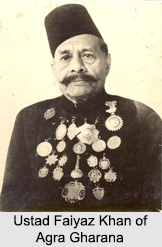 Style of Agra Gharana, or the Agra Gharana Gayaki has many components to it. A number of factors may be noticed in the tradition and training of the Agra gharana. It has been seen that the Agra gharana was originally a dhrupad gharana and Nauhari Bam was its chief mode. Khayal was introduced in the style of Gara Gharana by Ghagghe Khudabaksh, which he learnt form Natthan Pirbaksh of Gwalior. Moreover, after Ghagghe Khudabakhsh, khayal gayaki was the chief form practised, yet dhrupad-dhamar were also learnt and sung.
Style of Agra Gharana, or the Agra Gharana Gayaki has many components to it. A number of factors may be noticed in the tradition and training of the Agra gharana. It has been seen that the Agra gharana was originally a dhrupad gharana and Nauhari Bam was its chief mode. Khayal was introduced in the style of Gara Gharana by Ghagghe Khudabaksh, which he learnt form Natthan Pirbaksh of Gwalior. Moreover, after Ghagghe Khudabakhsh, khayal gayaki was the chief form practised, yet dhrupad-dhamar were also learnt and sung.
The training of both khayal and dhrupad-dhamar, being imparted together is not very unique. In fact in all khayal gharanas, some training of dhrupad is always given. However it requires to be noted that both dhrupad and khayal were sung in Agra Gharana till recently, which is significant. In other gharanas hardly any training is now given in dhrupad gayaki. But dhrupad and khayal have influenced each other mutually in Agra Gharana with obvious advantage. Though insistence was upon khayal in the Gharana, certain musical features of dhrupad-dhamar were so mingled in khayala that it became enriched. This characteristic blending of the two forms was prominently present in Natthan Khan`s singing. The techniques of dugun, cogun, athgun, layakan, bola-tana, tihai of bola-tana, lapet of bola, balancing the words of bandish with stressed and unstressed beats, bola-bant, openness of utterance, etc. were used by Natthan Khan in khayal. It is not easy to combine these dhrupad features with bandisa, only a creative artiste could accomplish such a task.
While discussing the Agra gharana, certain features have to be taken into account. These are- Utterances of svaras: Svaroccara, Raaga-vistara, Cija and bandisa, Laya-tala and Tana. In any discussion on gharanas, the voice of a prominent singer in the gharana and his characteristic use of it become the basis for explaining its subtleties but the gayaki of a gharana and an individual`s voice quality are two different beauty aspects.
Svaroccara of Agra Gharana
In dhrupad-dhamar, the svaras when uttered are open and bare (i.e. without grace notes). Even the projection of voice is more forceful and vigorous than in khayal. Because both khayal and dhrupad were parallel in training in Agra Gharana, the voice factor which ought to be different from each other did not remain so. The "Voice device" of dhrupad, became an integral part of khayal. This unique feature got an impetus in Faiyaz Khan, in whom the voice became impressively powerful and voluminous. Faiyaz Khan gharana bass tonal range and Agra became, as it were, synonymous. On the other hand, many women singers, with high pitched voices also mastered the gayaki of this gharana, so kharaj svam did not remain an inseparable part of Agra gayaki. In nom-thom, in presenting a bandisa, or in employing minda or gamaka, in dhrupad or khayal the svaras are sung open-throated. This typical use of forceful and vigorous voice is a special feature of Agra Gharana, and a bandisa or a cija sung in such a voice is considered a mark of distinction.
Raaga Vistara
Raaga vistara can be done in two ways. One way of doing it, is to minimize the dominance of a cija, develop a raaga through an elaborate exposition of the raaga-anga keeping raaga in the centre. Another way is to use cija as a medium and create a form within a form by cijavistara or cija-ki-badhat. Agra Gharana belongs to the latter fold. In Indian classical music, what is presented is a raaga, which emerges through a bandisa in case of vocal and through a gata in instrumental music. A bandisa is a special melodic design of a raaga. In Agra Gharana the training in singing Cija or bandisa was considered important as it facilitated the training or teaching of a raaga. It can be said that the cija frequently sung in Agra style was considered as belonging to Agra Gharana. They say that a raaga is infinite, and can be seized only through a finite cija, which gives a form to the formless raaga. A cija embodies a raaga in its composition. To liberate a raaga from it, there is its vistara. Singing a cija by elaborating its various parts, is elaborating the very form of a raaga.
Cija and Bandisa
Singing bandisas has been a matter of tradition and style as well as of repute for Agra Gharana musicians. Bandisa is a successful device to display different facets of a raaga. Each bandisa has a special musical aesthetic mood, which cannot be explained through literary jargon. When a bandisa is sung with a proper understanding of its mood on the singer`s part, it becomes all the more beautiful. Rhythm-devised and internal stresses of a tala, are closely related to a bandisa, the quality of which is judged by its co-ordination with the tala. A singer has to manage tala, while going into vistara through bola-badhata, bola-bant tana, etc. Thus, svams, laya, tana and bola together create a distinct form of a raaga and Agra gayaki manages these four things with utmost aesthetic propriety.
All gharanas utilize cija, but from the training point of view the importance given to cija in Agra Gharana is missing elsewhere. Their belief in unfolding raaga through cija has led to uncommon and unknown raagas being sung in the gharana, depending largely on cija. As a result, a raaga can be easily identified by its cija. In khayala raaga-vistara or alaap employs either svaras or bola, or both. Bola-alaap can musically exploit the "phonic" or the "sound" elements of the words. Agra Gharana uses both akara and bola-alaap.
Laya Tala
Layakan follows cija and alaap in khayal. It mainly uses bola-tana, and bola-bant, to manage which laya has to be increased. This development to proper laya is an attractive characteristic of the gharana. The gharana`s exposure and study of hon and dhamar, have influenced its psychology of music. Hon is a delightful composition, usually erotic, sung to the accompaniment of pakhavaj. There is a lot of scope for playing upon the meanings of words, laya, laya and svara, etc. This kind of indulgence into vocal acrobatics of laya and the accompanying pakhvaja create a tumultuous atmosphere. Khayala can ceate some such tumult only when laya is wrestled with. Agra gayaki uses bola-tana, bola-banta, khanapun, forceful utterance, etc. in khayala revealing the shadow of dhamar. Agra gayaki has successfully adopted vigour, force, masculinity, etc. of dhamar, which become apparent in tana, gamaka and the very pitch of voice. Overall loudness of voice and the voluminous delineation of svara became integral parts of Agra style.
Tana-Prastara
Tanas are a part of raaga-vistara. They produce variety in the manifestation of a raaga. Differently paced and designed movement of svaras creates various patterns, which help in providing richness, rests, paragraphing, all leading towards a completeness of a raaga presentation. Agra Gharana excels in rendering tanas befitting each aspect of khayal. Tana-matching laya, tana stretching over more than one avartana of tola, jadbe-ki-tana, gamaka, sapat tana and firat, are frequently used. Sapat tana of very fast laya is almost absent. The gharana also differentiates between tana for asthayi and tana for antara. In rendering firat according to tala and laya, people like Natthan Khan, have made the Agra Gharana unparalleled.
One gets to know the form of Agra gayaki when the components mentioned above are presented as a coherent whole. Individual voice, mood, preference for a particular aspect of gayaki have led to a characteristic style being formed.
The question whether Agra Gharana has its own dhrupad gayaki, can be answered if there are various gharanas of dhrupad existing at present. Dhrupad is said to have different gharanas on the basis of the kinds of bam. Yet the distinctiveness which one can easily mark in various khayala gharanas is missing in the so-called different dhrupad styles. Dhrupad of today is of one kind. Dhrupad of Bengal kirtans tradition and of Haveli Sangita can be differentiated, yet the stylishness of gharana would be missing from them. Agra dhrupad certainly has that uniqueness which is found in Dagar Brother`s dhrupad. But dhrupad has diminished in popularity. Khayal has become the dominant form of Agra Gharana. The gayaki of this gharana extends only to the khayala.
It must be stated here that in comparison to all the other gharanas, the Agra Gharana is the richest and most comprehensive in its repertoire of raagas, as well as cijas (compositions).
